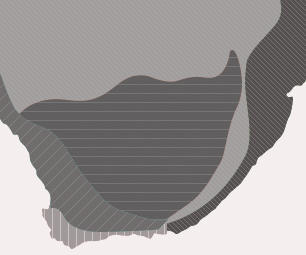Ledebouria lepida
Ledebouria lepida (N.E.Br.) S.Venter.
Family: Hyacinthaceae
Common names: Waterberg African hyacinth
Introduction
A curious dwarf novelty Ledebouria from the Waterberg in the Limpopo Province that is rare in the wild and creates a colourful display of small purple flowers in late summer when it flowers en masse after the late summer rains.

Description
Description
Dwarf bulbous plant forming dense clumps of numerous individuals from seed in shallow, sand-filled pans. The small bulbs produce two, erect, sparsely spotted, bright green leaves, each between 40–70 mm long, with longitudinal rows of setae (tiny hairs) on the upper leaf surfaces, leaf bases and peduncles (flower stalks).

Slender stalks are produced from within the leaves in late summer bearing numerous, small, bright purple to lilac flowers on short pedicels (stalks). After the fading of the flowers, abundant seed is produced, which usually falls and germinates around the base of the adult plants during the following rainy season.

Conservation Status
Status
This species is listed as Rare (R) in the Red List of South African plants, because it is known from only 3 locations. Despite its rarity, it is not considered to be faced with significant threats in its natural habitat.
Distribution and habitat
Distribution description
This species is endemic to the Limpopo Province in South Africa where it is known only from a few locations in the Waterberg Mountain range.
Derivation of name and historical aspects
History
The genus Ledebouria is named in honour of the German-Estonian botanist, Professor Karl Friedrich von Ledebour (1785–1851). The species name lepida, meaning ‘charming’, ‘pleasant’, ‘elegant’, ‘neat’, was given to the plant by N.E. Brown in 1921, who first named the species as a type of Scilla (Scilla lepida) It was later moved into Ledebouria. The exact intention of the original author is not known, but it was probably in reference to the pretty display the tiny plant makes when it flowers.
The genus Ledebouria has close to 100 species extending from India across the Arabian Peninsula, southwards through Africa, down to South Africa, with the highest level of diversity in the eastern side of southern Africa centered in the Mpumalanga and Limpopo Provinces. New species are constantly being discovered in this highly variable group of plants, with three new species being named in 2015. South Africa has 43 Ledebouria species.
The Waterberg African hyacinth is similar in many respects to Ledebouria rupestris, which has a similar size and growth habit, and also produces erect flower spikes with very small, brightly coloured flowers. However, Ledebouria rupestris is also highly restricted to only one known locality in the Mpumalanga Province of South Africa (some 200 km to the southeast). The flower colour is less purple and more mauve, the leaves have pappilate ridges as opposed to tiny setae (hairs) as is the case in L. lepida. L. rupestris also lacks the pilose scape (hairy flower stalk) of L. lepida.

Ecology
Ecology
Ledebouria lepida occurs in open sandy patches, often overlying shallow rock in mixed broadleaf savanna. The flowers are open and cup-shaped which suggests that they are opportunistically pollinated by most visiting insects, although honey bees have been seen visiting the flowers, as well butterflies, solitary bees and several other small insects. The black to brownish seed is drop-shaped with a wrinkled surface. It is suggested in one text that they are distributed by water wash, which is likely after heavy thunderstorms which are frequent in many of the areas where the species occurs.
Uses
Use
There are no known uses of this species other than occasionally being cultivated as a novelty pot plant by collectors and gardeners.

Growing Ledebouria lepida
Grow
Ledebouria lepida is best cultivated in a clean, fine, sharp, sandy soil with good drainage. The addition of a small amount of sifted kraal (cattle) manure and a little bone meal is beneficial. This species is not well suited to being grown in the garden, partly due to its small size, but also due to its specific soil and environmental requirements. Plants require a warm climate with watering in the form of heavy downpours between each period of almost complete drying out in summer. They should be kept in a full sunny position and exposed to rain; shaded plants tend to become floppy. During the dry winter dormancy period the pots should be moved out of the rain and placed in a cool dry area with good air movement. Watering can commence at the onset of warmer weather in spring (September to October in South Africa).
Propagation from seed is a successful method of producing more plants. Seed can be left to drop in the mother pot where it will germinate and develop around the parent plants. In the nursery, seed should be sown in spring or summer in seed trays filled with a sifted sandy soil with good drainage, with some sifted manure added. The seed can be sown on a firmly tamped surface and lightly covered with the same mixture approximately 1–3 mm deep. The trays should be kept in a bright, warm, well-ventilated position out of direct sunlight, and kept damp for between 1 and 3 weeks, until germination has commenced. Once the seedlings have emerged, watering can be gradually reduced and sunlight can be increased. Bulblets can remain in the seedling tray for 1 year or more and planted out at the beginning of their second or third growing season. Flowering size bulbs can be attained after two to three years.
References
- Hankey, A. 2003. Distinguishing between Ledebouria, Drimiopsis and Resnova. PlantLife (S. Afr.) 29: 38, 39.
- Hankey, A. 2011-07. Ledebouria Roth (Hyacinthaceae). http://pza.sanbi.org/ledebouria-genus. Internet 5 pp.
- Venter, S. 1993. A revision of the genus Ledebouria Roth (Hyacinthaceae) in South Africa. Unpublished M.Sc. thesis, University of Natal, Pietermaritzburg.
- Venter, S. & Edwards, T.J. 1998. A revision of Ledebouria (Hyacinthaceae) in South Africa. 2. Two new species, L. crispa and L. parvifolia, and L. macowanii re-instated. Bothalia 28(2): 179–182.
- Victor, J.E. & Hankey, A.J. 2005. Ledebouria lepida (N.E.Br.) S.Venter. National Assessment: Red List of South African plants version 2015.1. Accessed 2016/03/28 http://redlist.sanbi.org/species.php?species=3800-26
- Dictionary of Botanical Epithets. Accessed 2016/03/28 http://www.winternet.com/~chuckg/dictionary.html
Credits
Andrew Hankey
Walter Sisulu National Botanical Garden
May 2016
Plant Attributes:
Plant Type: Bulb
SA Distribution: Limpopo
Soil type: Sandy
Flowering season: Late Summer
PH: Acid
Flower colour: Purple, Mauve/Lilac
Aspect: Full Sun
Gardening skill: Average
Special Features:
Horticultural zones








Rate this article
Article well written and informative
Rate this plant
Is this an interesting plant?
Login to add your Comment
Back to topNot registered yet? Click here to register.